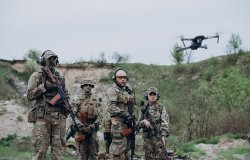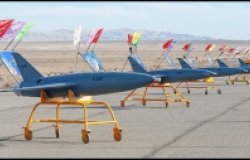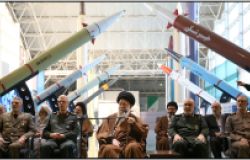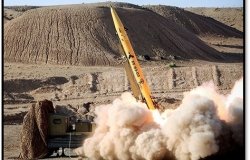The Outlook for Canada-U.S. Defense Cooperation
The Canada Institute hosted a panel discussion on the outlook for Canada-U.S. defense relations prior to the conclusion of the Bi-National Planning Group's mandate, at which authors presented the key findings and recommendations of the BPG’s final report.
Overview
Capt(N) Richard Bergeron, Canadian Forces, Co-Director, Bi-National Planning Group.
CAPT. Pamela McClune, United States Navy, Co-Director (Acting), Bi-National Planning Group.
Joseph T. Jockel, Director, Canadian Studies Program, St. Laurence University, and Visiting Professor, Canadian Forces College.
Col. (Ret.) John Orr, Research Fellow, Centre for Foreign Policy Studies, Dalhousie University
The Wilson Center's Canada Institute hosted a panel discussion on the outlook for Canada-U.S. defense relations prior to the conclusion of the Bi-National Planning Group's mandate on May 12, 2006. The BPG has just released its final report outlining observations, findings, and recommendations to improve Canada-U.S. defense and security cooperation. Capt. Richard Bergeron and CAPT. Pamela McClune, the BPG co-director and acting co-director, respectively, presented the report's key findings and recommendations. Dr. Joseph Jockel and Col. (ret.) John Orr then commented and the report.
The BPG was established in 2002 with two-year mandate—extended for another two years until May 2006—to enhance defense cooperation between Canada and the United States through joint military planning, surveillance, and support to civilian authorities. Although the Permanent Joint Board on Defense (PJBD) and the Military Cooperation Committee (MCC) remain intact (albeit somewhat "moribund" according to Col. Orr), the BPG had a clear mandate to prevent or mitigate threats to continental security and ensure cooperative, well coordinated responses across the two countries. With a full-time staff of up to 50 Canadian and U.S. defense personnel, the BPG thus tackled the strategic questions related to continental security in the aftermath of the September 11 attacks.
The BPG's first challenge was grappling with the lack of an overarching, strategic vision for Canada-U.S. defense relations. Accordingly, prominent among the report's recommendations is a call for a comprehensive defense and security agreement between the two countries, to replace the "ad hoc" approach in bilateral defense relations with a "formal," "systematic" way of doing things. The absence of a formal framework embodied in a bilateral agreement has not proved an obstacle in the past, as Jockel explained. Indeed, up until now, bilateral defense relations have proceeded informally, characterized by a "limited, bureaucratic, functional approach." To consider a formal agreement as envisaged in the BPG report would entail a "significant break with how the two countries have conducted defense relations to date," according to Jockel. In this sense, he cautioned against expecting far-reaching changes in Canada-U.S. defense relations, which in the past have often been characterized by "empty declarations of intent."
The BPG co-directors explained that the need for a formal framework for cooperation arises from the fundamental shift in security threats since September 11, coupled with the enduring interdependence between the Canadian and U.S. economies. Furthermore, the creation of Northern Command (NORTHCOM), located in Colorado Springs, and Canada Command (CANADACOM) in Ottawa have added a new layer in an already complex web of bilateral defense relations. The creation of the Department of Homeland Security (DHS) in the United States and Public Safety and Emergency Preparedness Canada (PSEPC) in Canada has further complicated the picture. The emergence of these new stakeholders rendered old strategic and operations plans obsolete, and created new challenges regarding interoperability requirements, human resource management, and coordination and review mechanisms.
In light of this new situation, the BPG set out to draft three new plans: (i) a "basic defense document" to provide overall strategic guidance; (ii) a civil assistance plan to guide military-to-military interaction in situations requiring the armed forces to assist civilian agencies; and (iii) a combined defense plan. All are due out this year. Four critical gaps stood out as a result: (1) the need for interoperability; (2) the need for systematic information sharing, unencumbered by "stovepipes"; (3) the need for a secure, reliable, comprehensive "communications architecture"; and (4) the need for a "combined vision, articulated by a comprehensive defense and security agreement."
The BPG report outlines four concepts to implement such a combined continental defense and security strategy, which take into account the legacy organizations such as NORAD, the PJBD, and the MCC, as well as the new command centers and civilian organizations in the United States and Canada. Each concept is explained in detail, but the report is non-prescriptive and eschews any mention of a preferred option. Jockel commended the report's extensive overview for each concept, which will prove timely as the two governments consider NORAD renewal. He remarked that Stephen Harper's government favors a two-year renewal of the NORAD agreement instead of the renewal in perpetuity considered by the Martin government only a year ago. The two-year timeframe will force both sides to give serious consideration to NORAD's purpose, mandate, and raison d'être. As such, the BPG report with its four concepts is extremely timely.
Jockel considered each concept in turn. The first one envisions three command centers—NORTHCOM, NORAD, and CANADACOM. According to Jockel, it is the most probable option, at least in the short term, since it relies on existing organizations without having to create new ones. It may, however, result in growing tensions between the three command centers, likely more detrimental to NORAD as the other two centers assert themselves nationally. The second concept would entail the creation of a single, North American Defense Command. While this option offers many benefits from a planning and response perspective, Jockel argued that it would not get necessary political backing in either country. Indeed, when the idea was first floated in the aftermath of September 11, 2001, it failed to gain traction because "Canada didn't trust the United States with its identity and the United States didn't trust Canada with its security." Revisiting the concept of a single command for North America would likely provoke similar underlying misgivings, especially in Canada.
The last two options offered the most interesting ideas. One envisions the creation of a Standing Combined Joint Task Force responsible to NORTHCOM and CANADACOM. The other would lead to the establishment of a Continental Joint Interagency Task Force, responsible to both command centers as well as to DHS and PSEPC. Col. Orr pointed out, however, that both DHS and PSEPC were still "sorting themselves out" and may therefore lack the focus to address security threats binationally. Until each asserts itself and outgrows their respective "teething pains" it may be premature to expect a sustained focus on the bilateral aspect of continental defense and security issues. He also cautioned against the assumption that providing civil assistance could function the same way in both countries. Whereas in Canada the military has a long track record of intervening to deal with strikes, civil unrest, etc., this is not the case in the United States. The historical, legal, and cultural differences between the two countries still bear reminding when considering combined efforts to tackle common problems. But all agreed that working side-by-side was more effective than going it alone.
The Canada Institute has addressed Canada-U.S. defense relations on a number of occasions, including in our One Issue, Two Voices publications series. The third issue, Security and Sovereignty: Renewing NORAD, explored the possibility of expanding the North American Aerospace Defense Agreement to include maritime and, possibly, land defense as well. The fourth issue in the series, Threat Perceptions in the United States and Canada, provided an insightful comparison of the primary motivators that inform Americans' and Canadians' views of threats to their security. Both Publications are available for download in PDF.
David N. Biette
Director, Canada Institute
(202) 691-4133
Drafted by Christophe Leroy
Hosted By

Canada Institute
The mission of the Wilson Center's Canada Institute is to raise the level of knowledge of Canada in the United States, particularly within the Washington, DC policy community. Research projects, initiatives, podcasts, and publications cover contemporary Canada, US-Canadian relations, North American political economy, and Canada's global role as it intersects with US national interests. Read more
Thank you for your interest in this event. Please send any feedback or questions to our Events staff.










